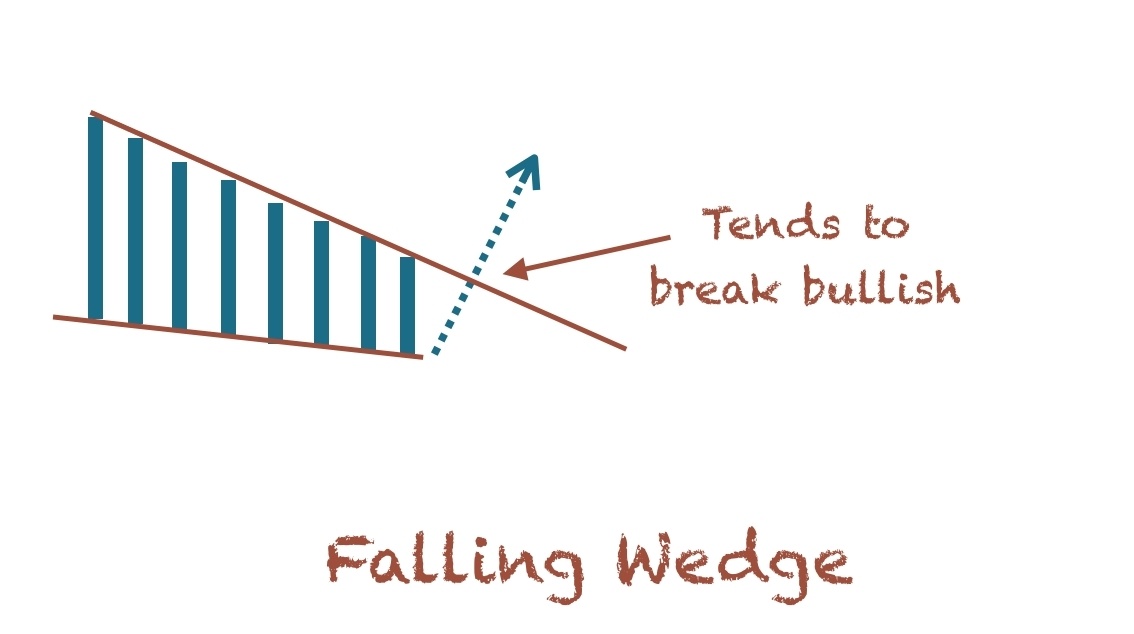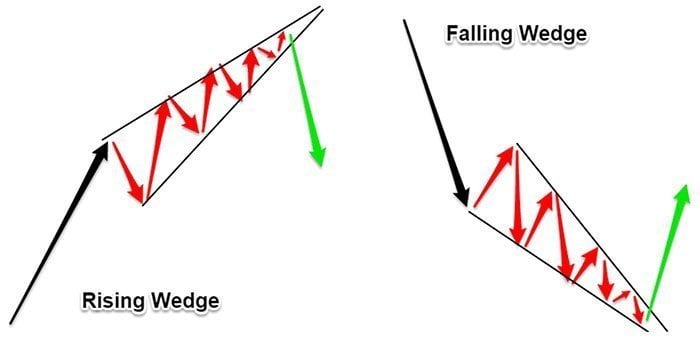

In this case, the price broke to the downside and the downtrend continued. Only this time it acts as a bearish continuation signal.Īs you can see, the price came from a downtrend before consolidating and sketching higher highs and even higher lows. Now let’s take a look at another example of a rising wedge formation. Just like in the other forex trading chart patterns we discussed earlier, the price movement after the breakout is approximately the same magnitude as the height of the formation. They pushed the price down to break the trend line, indicating that a downtrend may be in the cards. See how price broke down to the downside? That means there are more forex traders desperate to be short than be long! Notice how price action is forming new highs, but at a much slower pace than when price makes higher lows. In this first example, a rising wedge formed at the end of an uptrend. Let us assume that in the price chart of an asset, the price breaks out of the falling wedge upward before returning down again in a scenario known as "fakeout" or fake breakout.On the other hand, if it forms during a downtrend, it could signal a continuation of the down move.Įither way, the important thing is that, when you spot this forex trading chart pattern, you’re ready with your entry orders! One benefit offered by trading breakouts is that it is usually clear when a potential move is no more valid. This is determined by the gap between the high and low of the wedge from the start. The second rule is that the previous channel's range can be an indication of the size of an ensuing move. These points of resistance can then turn into levels of support in the next rising moves. For instance, EUR/USD may hit 1.13, 1.14, or 1.15 as its peaks in a falling wedge. The first rule is that previous levels of support are likely to become new resistance and vice versa.

A sudden increase in volume after a breakout is a good signal that a larger move is imminent.įor this aspect, the trader has to rely on two general rules about trading breakouts. Once it starts, you are looking for a substantial move that is beyond the resistance trendline.Īnother way to confirm a wedge that is about to have a breakout is if you notice that the volume is falling as the market consolidates. One way of confirming the move is to wait for the breakout to begin. You have to bear in mind that not all falling wedges will result in a breakout which is why you must confirm the move before a position is opened. In building a strategy with the falling wedge pattern, there are 3 important things to consider: Find a break above resistance for a long entry.Technical tools like oscillators can then be used to validate oversold signals.Identify divergence between the price and an oscillator such as the stochastic indicator or RSI (Relative Strength Index).Use a trend line to connect lower highs and lower lows as the two lines will slope downwards before converging.Below are the steps for identifying a falling wedge pattern: It is a continuation pattern if it is seen in an uptrend while if it appears in a downtrend, then it is a reversal pattern. See Also: 7 Most Reliable Price Patterns RankedĪ falling wedge pattern can either be a continuation or reversal pattern depending on the trend direction when the falling wedge is formed. The image below depicts a typical falling wedge pattern. The falling wedge pattern is also known as the descending wedge pattern and it is an indication of future bullish momentum.

In such a case, the support and resistance lines must both point in a downwards direction with the resistance line being steeper than the support line. The falling wedge pattern is formed as a recognizable price move when a market consolidates between two converging lines of support and resistance.
#Falling wedge how to
This wedge pattern can either be a rising wedge pattern or a falling wedge pattern, but this article will be focusing on the falling wedge pattern as well as how to build a trading strategy with it. In most cases when a market is trending, a wedge pattern will be formed on the chart. Wedges are a form of technical chart pattern that is used for predicting trend reversals or continuations.

With a good trading strategy, you could use this pattern to earn maximum gains. The falling wedge pattern is especially known to form before a bullish breakout.


 0 kommentar(er)
0 kommentar(er)
